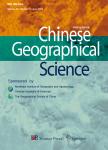Dynamic Changes in the Wetland Landscape Pattern of the Yellow River Delta from 1976 to 2016 Based on Satellite Data
Dynamic Changes in the Wetland Landscape Pattern of the Yellow River Delta from 1976 to 2016 Based on Satellite Data作者机构:National Marine Environmental Monitoring Center School of Urban and Environmental Science Liaoning Normal University
出 版 物:《Chinese Geographical Science》 (中国地理科学(英文版))
年 卷 期:2019年第29卷第3期
页 面:372-381页
核心收录:
学科分类:0303[法学-社会学] 08[工学] 0708[理学-地球物理学] 0705[理学-地理学] 0813[工学-建筑学] 0704[理学-天文学] 0833[工学-城乡规划学] 0834[工学-风景园林学(可授工学、农学学位)]
基 金:Under the auspices of National Key Research&Development Program of China(No.2017YFC0505901 2017YFA0604904)
主 题:landscape pattern object-oriented classification landsat wetlands Yellow River Delta
摘 要:The Yellow River Delta wetland is the youngest wetland ecosystem in China s warm temperate zone. To better understand how its landscape pattern has changed over time and the underlying factors responsible, this study analyzed the dynamic changes of wetlands using five Landsat series of images, namely MSS(Mulri Spectral Scanner), TM(Thematic Mapper), and OLI(Operational Land Imager) sensors in 1976, 1986, 1996, 2006, and 2016. Object-oriented classification and the combination of spatial and spectral features and both the Normalized Difference Vegetation Index(NDVI) and Normalized Difference Water Index(NDWI), as well as brightness characteristic indices, were used to classify the images in eCognition software. Landscape pattern changes in the Yellow River Delta over the past 40 years were then delineated using transition matrix and landscape index methods. Results show that: 1) from1976 to 2016, the total area of wetlands in the study area decreased from 2594.76 to 2491.79 km^2, while that of natural wetlands decreased by 954.03 km^2 whereas human-made wetlands increased by 851.06 km^2. 2) The transformation of natural wetlands was extensive: 31.34% of those covered by Suaeda heteropteras were transformed into reservoirs and ponds, and 24.71% with Phragmites australis coverage were transformed into dry farmland. Some human-made wetlands were transformed into non-wetlands types: 1.55% of reservoirs and ponds became construction land, and likewise 21.27% were transformed into dry farmland. 3) From 1976 to 2016, as the intensity of human activities increased, the number of landscape types in the study area continuously increased. Patches were scattered and more fragmented. The whole landscape became more complex. In short, over the past 40 years, the wetlands of the Yellow River Delta have been degraded, with the area of natural wetlands substantially reduced. Human activities were the dominant forces driving these changes in the Yellow River Delta.



